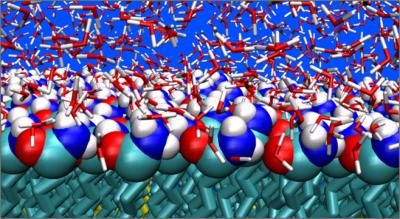Martian data and PANalytical X-ray analysis help confirm new mineral species
Advertisement
Inspired by data sent from NASA robots on Mars, Dr. Ronald Peterson, Professor of geology at Queen's University in Kingston, Canada, has observed a new mineral species on Earth, and predicts that it also exists on Mars. The mineral, meridianiite (MgSO4*11H2O), was named in acknowledgement of the cratered plain of Meridiani Planum on Mars, where one of the NASA robots is operating. Integral to Dr. Peterson's work was the PANalytical X'Pert PRO X-ray diffractometer, which provided the necessary speed and flexibility for such highly sensitive analysis.
Dr. Peterson and his colleagues made their discovery at a frozen pond in British Columbia, Canada. From collection through to analysis, mineral samples had to be maintained at the sub-zero temperatures at which they were found. Even a small temperature rise would have altered the material completely.
The powder diffraction data, chemical analysis and physical properties were submitted to the International Mineralogical Association who approved the material as a valid new mineral species, and accepted the name meridianiite. It is expected that Meridianiite is the magnesium sulfate mineral in equilibrium with ice in the polar caps of Mars.
The search for the new mineral began with data from two NASA Mars Exploration Rovers (MER). MER images of euhedral molds in sedimentary rock, together with data showing magnesium rich soil, led Dr. Peterson to suspect that the observed crystal molds could be formed by MgSO4*11H2O crystals precipitated from a MgSO4 rich solution. Such crystals were only known to form synthetically on Earth. With this information, Dr. Peterson set out to find sites where the material could occur naturally.
Frozen ponds in British Columbia, which were once mined for magnesium sulfate, were identified as a potential location. Here Dr. Peterson found a tree trunk protruding from the ice that had drawn up the pond solution and allowed it to evaporate in air, at colder temperatures than below the ice. This resulted in the deposition of off-white crystals, which later proved to be meridianiite.
Organizations
Other news from the department science
These products might interest you

Get the chemical industry in your inbox
By submitting this form you agree that LUMITOS AG will send you the newsletter(s) selected above by email. Your data will not be passed on to third parties. Your data will be stored and processed in accordance with our data protection regulations. LUMITOS may contact you by email for the purpose of advertising or market and opinion surveys. You can revoke your consent at any time without giving reasons to LUMITOS AG, Ernst-Augustin-Str. 2, 12489 Berlin, Germany or by e-mail at revoke@lumitos.com with effect for the future. In addition, each email contains a link to unsubscribe from the corresponding newsletter.




































































